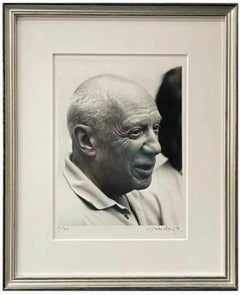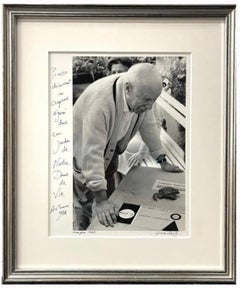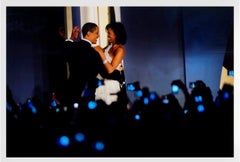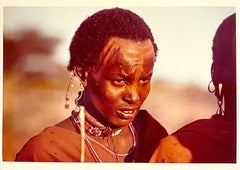Koo Stark
Black and white silver gelatin portrait photograph of photographer Horst P. Horst, official 80th birthday image.
Frame: 17 1/4 x 23 1/4 inches
Sight: 10 1/4 x 13 1/4 inches
Condition: Good.
Kathleen Norris Stark (born April 26, 1956), better known as Koo Stark, is an American photographer and actress, known for her relationship with Prince Andrew. She is a patron of the Julia Margaret Cameron Trust, which runs the museum of the Victorian pioneer photographer.
Early life and education
Stark was born in New York. Her parents were Wilbur Stark, a writer and producer, and Kathi Norris, a writer and television presenter in New York City. She is the youngest of three children, the others being Pamela and Brad. At the time of her birth, the family was living in the city's Manhattan borough.[1] Her grandfather, Edwin Earl Norris, was a cabinetmaker and musician, playing the French horn and the viola in the Newark Symphony Orchestra. Her mother's family were Presbyterians.[2][3] After a divorce in the 1960s, her mother remarried.[4]
Koo Stark attended the Hewitt School in New York and the Glendower Preparatory School in Kensington, London. After training at a stage school, she began her film acting career. (she acted in the original Star Wars!)
Stark also began to work as a fashion model, particularly for Norman Parkinson. In February 1981, she was at the National Theatre as an understudy in the Edward Albee play Who's Afraid of Virginia Woolf?
Stark has worked as a photographer since the 1980s, and may have been the first person to turn the tables on the pursuing paparazzi by taking photos of them. Prince Andrew has told how in 1983 a photographic printer, Gene Nocon, invited Stark to take photographs of people taking photos of her, for his exhibition, Personal Points of View, planned for October. She persuaded Nocon to include Andrew's work as well. Her early photographs led to a book deal, for which she took lessons from Norman Parkinson. She travelled to Tobago, where he lived, and he became her mentor. Her book Contrasts (1985) included about a hundred of her photographs. She went on to study the work of leading photographers, including Angus McBean, whom she met and photographed, developing her interests in photography to include reportage, portraits, landscapes, still life, and other work.
The book Contrasts was launched at Hamiltons Gallery, London, in September 1985, at an exhibition of the same name. In 1994, the Gallery Bar at the Grosvenor House Hotel in Park Lane hosted an exhibition called 'The Stark Image', forty photographs by Stark, including several previously unpublished. In 1998, her work was featured at the Como Lario in Holbein Place, Belgravia. In July 2001 she had an exhibition called 'Stark Images" at the Fruitmarket Gallery in Edinburgh, duplicated from June to July 2001 at Dimbola Lodge on the Isle of Wight. A solo exhibition of portraits was at the Winter Gardens, Ventnor, from September to October 2010,[29] and another at Dimbola Lodge from February to April, 2011.
On 22 April 1987, a charity auction at Christie's, St James's, for the Campaign to Protect Rural England, featured signed work by David Bailey, Patrick Lichfield, Don McCullin, Terence Donovan, Fay Godwin, Heather Angel, Clive Arrowsmith, Linda McCartney, Koo Stark, and fifteen others, Views by Stark, including some of Kirby Muxloe Castle, were in G. H. Davies's England's Glory (1987), a CPRE book launched at the same time.
Pictures by Stark have appeared in Country Life and other magazines. Several of her portraits are in the National Portrait Gallery, and work is also in the collections of the Victoria and Albert Museum, both in London.
A Leica user, Stark has said her camera transcends mere function and is a personal friend. A solo exhibition hosted by the Leica gallery in Mayfair in May 2017 was entitled Kintsugi, a Japanese word for a way of renovating things that have been broken. Stark explained the title: "Kintsugi is a way of learning to see individual beauty, and to appreciate the value of experience and honesty. It is the antithesis of digital, airbrushed, Photoshop-homogenised 'beauty'." In August the exhibition was repeated in Manchester, to mark the opening of a new Leica store there.
Stark has been a practising Buddhist since meeting the Dalai Lama. She continues to live in London and is a member of the Chelsea Arts Club. She is a Patron of the Julia Margaret Cameron Trust, at Dimbola Lodge on the Isle of Wight, home of the Victorian pioneer photographer Julia Margaret Cameron.
Stark met Prince Andrew in February 1981, and they were close for some two years, before and after his active service in the Falklands War. Tina Brown has claimed that this was Andrew's only serious love affair. In October 1982 they took a holiday together on the island of Mustique. According to Lady Colin Campbell, Andrew was in love, and the Queen was "much taken with the elegant, intelligent, and discreet Koo". However, in 1983, after 18 months of dating, they split up under pressure from the Queen. In 1997, Prince Andrew became the godfather of Stark's daughter, and in 2015, when the Prince was accused by Virginia Roberts over the Jeffrey Epstein connection, Stark came to his defence, stating that he was a good man and she could help to rebut the claims.
Photographic exhibitions
'Contrasts', Hamiltons Gallery, Carlos Place, London, September 1985
'The Stark Image', Gallery Bar at Grosvenor House Hotel, London, 1994
'Stark Images', Dimbola Lodge, Isle of Wight, June to July 2001
'Stark Images', Fruitmarket Gallery, Market Street, Edinburgh, July 2001
'Portraits by Koo Stark', Winter Gardens, Ventnor, Isle of Wight, September to October 2010
'Koo Stark: Contrasts', Dimbola Lodge, Isle of Wight, February to April, 2011
'Kintsugi', Leica gallery, Bruton Place, Mayfair, May 2017
'Kintsugi', Leica store, Police Street, Manchester, August 2017
'Kintsugi Portraits', San Lorenzo, Beauchamp Place, London SW3, November 2017
Horst Paul Albert Bohrmann (1906 – 1999), who chose to be known as Horst P. Horst, was a German-American fashion and Fine Art photographer.
The younger of two sons, Horst was born in Weißenfels-an-der-Saale, Germany, to Klara (Schönbrodt) and Max Bohrmann. His father was a successful merchant. In his teens, he met dancer Evan Weidemann at the home of his aunt, and this aroused his interest in avant-garde art. In the late 1920s, Horst studied at Hamburg Kunstgewerbeschule, leaving there in 1930 to go to Paris to study under the architect Le Corbusier.
While in Paris, he befriended many people in the art community and attended many galleries. In 1930 he met Vogue photographer Baron George Hoyningen-Huene, a half-Baltic, half-American nobleman, and became his photographic assistant, occasional model, and lover. He traveled to England with him that winter. While there, they visited photographer Cecil Beaton, who was working for the British edition of Vogue. In 1931, Horst began his association with Vogue, publishing his first photograph in the French edition of Vogue in December of that year. It was a full-page advertisement showing a model in black velvet holding a Klytia scent bottle.
His first exhibition took place at La Plume d'Or in Paris in 1932. It was reviewed by Janet Flanner in The New Yorker, and this review, which appeared after the exhibition ended, made Horst instantly prominent. Horst made a portrait of Bette Davis the same year, the first in a series of public figures he would photograph during his career. Within two years, he had photographed Noël Coward, Yvonne Printemps, Lisa Fonssagrives, Count Luchino Visconti di Modrone, Duke Fulco di Verdura, Baron Nicolas de Gunzburg, Princess Natalia Pavlovna Paley, Daisy Fellowes, Princess Marina of Greece and Denmark, Cole Porter, Elsa Schiaparelli, and others like Eve Curie.
Horst rented an apartment in New York City in 1937, and while residing there met Coco Chanel, whom Horst called "the queen of the whole thing". He would photograph her fashions for three decades. He met Valentine Lawford, British diplomat in 1938, and they lived together until Lawford's death in 1991. Horst adopted a son, Richard J. Horst, whom they raised together. In 1941, Horst applied for United States citizenship. In 1942, he passed an Army physical, and joined the Army on July 2, 1943. On October 21, he received his United States citizenship as Horst P. Horst. He became an Army photographer, with much of his work printed in the forces' magazine Belvoir Castle. In 1945, he photographed United States President Harry S. Truman, with whom he became friends, and he photographed every First Lady in the post-war period at the invitation of the White House. In 1947, Horst moved into his house in Oyster Bay, New York. He designed the white stucco-clad building himself, the design inspired by the houses that he had seen in Tunisia during his relationship with Hoyningen-Huene.
Horst is best known for his photographs of women and fashion, but is also recognized for his photographs of interior architecture, still lifes, especially ones including plants, and environmental portraits. One of the great iconic photos of the Twentieth-Century is "The Mainbocher Corset" with its erotically charged mystery, captured by Horst in Vogue’s Paris studio in 1939. Designers like Donna Karan continue to use the timeless beauty of "The Mainbocher Corset" as an inspiration for their outerwear collections today. His work frequently reflects his interest in surrealist style and surrealism and his regard of the ancient Greek ideal of physical beauty. Horst P Horst signed color photograph in color. Horst is listed as one of the best photographers ever along with Diane Arbus, Ansel Adams, and Robert Mapplethorpe His method of work typically entailed careful preparation for the shoot, with the lighting and studio props (of which he used many) arranged in advance. His instructions to models are remembered as being brief and to the point. His published work uses lighting to pick out the subject; he frequently used four spotlights, often one of them pointing down from the ceiling. Only rarely do his photos include shadows falling on the background of the set. Horst rarely, if ever, used filters. While most of his work is in black & white, much of his color photography includes largely monochromatic settings to set off a colorful fashion. Horst's color photography did include documentation of society interior design, well noted in the volume Horst Interiors. He photographed a number of interiors designed by Robert Denning and Vincent Fourcade of Denning & Fourcade and often visited their homes in Manhattan and Long Island. After making the photograph, Horst generally left it up to others to develop, print, crop, and edit his work. One of his most famous portraits is of Marlene Dietrich, taken in 1942. She protested the lighting that he had selected and arranged, but he used it anyway. Dietrich liked the results and subsequently used a photo from the session in her own publicity.
In the 1960s, encouraged by Vogue editor Diana Vreeland, Horst began a series of photos illustrating the lifestyle of international high society which included people like: Consuelo Vanderbilt, Marella Agnelli, Gloria Guinness, Baroness Pauline de Rothschild and Baron Philippe de Rothschild, Helen of Greece and Denmark, Baroness Geoffroy de Waldner, Princess Tatiana of Sayn-Wittgenstein-Berleburg, Lee Radziwill, Duke of Windsor and Duchess of Windsor, Peregrine Eliot, 10th Earl of St Germans and Lady Jacquetta Eliot, Countess of St Germans, Antenor Patiño, Oscar de la Renta and Françoise de Langlade, Desmond Guinness and Princess Henriette Marie-Gabrielle von Urach, Andy Warhol,
Nancy Lancaster...





